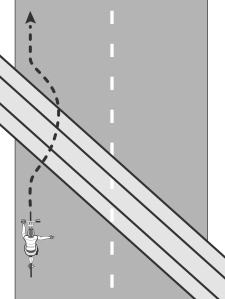Metal surfaces like access hole covers and tram and train tracks become super-slippery when wet. Avoid riding over any metal if you can but if you can’t, travel over it as directly as possible and do not try to make a turn because you’ll be down in a flash. Tram tracks in particular bring down many a bike rider at some time in their riding life. These should be crossed at an angle as close to 90 degrees as possible.

Painted road markings can also be slippery and should be approached as per metal surfaces. Wooden slats and some other boardwalk materials can also be glassy. The best thing you can do is slow down a bit and don’t try to make sudden turns.
From the people that bought you the Little Bike Bible: 356 tips to enjoy riding.
More Riding know how articles
More Tips articles
Ride On content is editorially independent, but is supported financially by members of Bicycle Network. If you enjoy our articles and want to support the future publication of high-quality content, please consider helping out by becoming a member.

great points. I especially like mention of wooden surfaces. Why is it that we keep being given wooden bike tracks when they are so dangerous?
On dedicated bike paths Local Government persist in building wooden decked bridges with bolts and nails that work loose and present a cycling hazard; whereas a ribbed concrete slab or ashphalt surfaced bridge is a much safer cycling surface .
Councils & Vicroads also persist in installing metal grates and grilles in roadways and kerbings where the grille design is parallel to direction of traffic rather than being at 90 degrees . The current design practice is dangerous in that a narrow bicycle wheel can get jammed down the grille and throw the rider from the cycle .
There’s been some heavy frosts in Canberra lately and ice on the bike paths – seen a few people go down.
It would be great if bike paths subject to icing had a warning sign ahead of the section, same as for roads.
slightly lifting the front wheel as you cross angled wet ridges (like driveway entrances) is a good skill to have. Knowing your road well, so unsighted badly angled steel grates are not a suprise.
All good things to practice.
Also watch out for the tactile bumps that are many places for the vision impared. In the wet they’re incredible slippery and they’re often right in the apex of corners. I even find these quite dangerous in certain footware as a pedestrian. I find it amazing that the design of these bumps appear to be the preferred method to indicate the path for the vision impared given the danger to cyclists and pedestrians.
What about those plastic ground tactile things they install at pedestrian intersections, these are especially dangerous on cycle paths where you are breaking and turning at the same time in a tight area, sometimes I think the people who design bike paths have no idea.
I’ve crashed twice on the oblong tactile bumps in the wet. They become similar to tram tracks, and you can’t avoid turning near them.